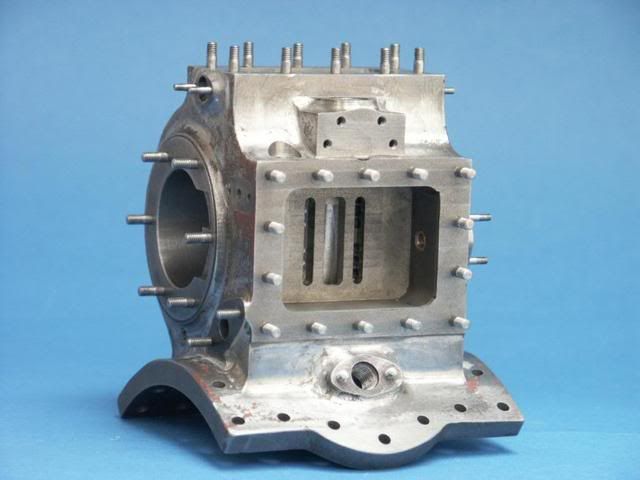Ba studs
Where from
| Terryd | 27/10/2012 12:00:41 |
1946 forum posts 179 photos | Hi All, This thread (no pun intended) started off a thought process as to the advantage of studs vs studding. I understood that studs were used to allow different threads to be used, e.g. in a cast iron or aluminium casting a coarse thread would be used, while for the fixing nut a relatively fine thread would be used - e.g BSW at casting end and BSF for the clamping nut. The theory, as I was led to believe, is that the coarse thread was less liable to be pulled out of the weaker or brittle material while the finer thread of the nut allowed a greater clamping force for a given torque. Hence the use of studs in models with the same thread both ends has no significant advantage, not even an aesthetic one as they cannot be seen. If aesthetics is important on early historic models surely it is more important to use square nuts as would be originally used. Strength of the stud would not be a factor as there must be extra redundant threads below the fixing nuts. Can anyone explain what other advantage there is that I may have missed? Best Regards Terry Edited By Terryd on 27/10/2012 12:04:14 |
| JasonB | 27/10/2012 12:58:12 |
25215 forum posts 3105 photos 1 articles | One reason for using proper studs if that the end can be threaded to a set length so that when you screw it into the hole it will protrude by a known amount regardless of how many turns the tap had threading the hole. This helps ensure that when everything is assembled you end up with the right amount of stud above the nut, especially on parts with lots of studs that may come in & out several times.
Also having a plain centre section allows you to grip the stud without crushing the creasts of the thread. The cost of studding can soon mount up, eg 8BA costs around £5.50 a foot but a similar length of rod cost say 50p
If the original engine had square nuts then I would make square ones to screw onto a proper stud, this is a pic of the fixings for a hit & miss all made including the ones with square heads on teh set screws, no hex sockets here.
J |
| Terryd | 27/10/2012 13:19:33 |
1946 forum posts 179 photos | Thanks Jason, Those are good enough reasons for me, Studs it is. Best regards Terry |
| Stub Mandrel | 27/10/2012 19:02:52 |
4318 forum posts 291 photos 1 articles | Copper plated plain welding rods are just the right size for 10BA studs and nice and soft so they don't ruin your dies. You can even gently run a 10BA die down a long (well lubricated) length of it under power without trouble. Neil |
| Ian S C | 28/10/2012 10:47:16 |
7468 forum posts 230 photos | One thing with studs, the plain unthreaded part is the full diameter, this may or may not be an advantage, other than that, all thread/studding is usually OK, unless as Terry says there is two different threads. On some special studs, the plain part is actually reduced in diameter, sometimes on a long one there is a short section at half way of full diameter. Ian S C |
Please login to post a reply.
Want the latest issue of Model Engineer or Model Engineers' Workshop? Use our magazine locator links to find your nearest stockist!
Sign up to our newsletter and get a free digital issue.
You can unsubscribe at anytime. View our privacy policy at www.mortons.co.uk/privacy
- hemingway ball turner
04/07/2025 14:40:26 - *Oct 2023: FORUM MIGRATION TIMELINE*
05/10/2023 07:57:11 - Making ER11 collet chuck
05/10/2023 07:56:24 - What did you do today? 2023
05/10/2023 07:25:01 - Orrery
05/10/2023 06:00:41 - Wera hand-tools
05/10/2023 05:47:07 - New member
05/10/2023 04:40:11 - Problems with external pot on at1 vfd
05/10/2023 00:06:32 - Drain plug
04/10/2023 23:36:17 - digi phase converter for 10 machines.....
04/10/2023 23:13:48 - More Latest Posts...
- View All Topics
- Reeves** - Rebuilt Royal Scot by Martin Evans
by John Broughton
£300.00 - BRITANNIA 5" GAUGE James Perrier
by Jon Seabright 1
£2,500.00 - Drill Grinder - for restoration
by Nigel Graham 2
£0.00 - WARCO WM18 MILLING MACHINE
by Alex Chudley
£1,200.00 - MYFORD SUPER 7 LATHE
by Alex Chudley
£2,000.00 - More "For Sale" Ads...
- D1-3 backplate
by Michael Horley
Price Not Specified - fixed steady for a Colchester bantam mark1 800
by George Jervis
Price Not Specified - lbsc pansy
by JACK SIDEBOTHAM
Price Not Specified - Pratt Burnerd multifit chuck key.
by Tim Riome
Price Not Specified - BANDSAW BLADE WELDER
by HUGH
Price Not Specified - More "Wanted" Ads...
Do you want to contact the Model Engineer and Model Engineers' Workshop team?
You can contact us by phone, mail or email about the magazines including becoming a contributor, submitting reader's letters or making queries about articles. You can also get in touch about this website, advertising or other general issues.
Click THIS LINK for full contact details.
For subscription issues please see THIS LINK.
Model Engineer Magazine
- Percival Marshall
- M.E. History
- LittleLEC
- M.E. Clock
ME Workshop
- An Adcock
- & Shipley
- Horizontal
- Mill
Subscribe Now
- Great savings
- Delivered to your door
Pre-order your copy!
- Delivered to your doorstep!
- Free UK delivery!












 Register
Register Log-in
Log-in


